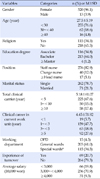Abstract
Purpose
The purpose of this study was to identify the effect of resilience and job placement on general hospital nurse's intention to relocate, prepare a practical transfer management plan, and provide basic data on effective personnel management.
Methods
Data were collected from 333 nurses in 2 general hospitals with more than 500 beds in P-city. Data analysis was performed using hierarchical regression with the SPSS/WIN 25.0 program.
Figures and Tables
References
1. Ministry of Health & Welfare (KR). Measures to improve working environment and treatment of nurses. Sejong: Ministry of Health & Welfare;2018.
2. Korean Hospital Nurses Association. A survey on hospital nursing staffing (2017). Business report for Hospital Nurses Association. Seoul: Korean Hospital Nurses Association;2018.
3. Jeon JH, Yom YH. Roles of empowerment and emotional Intelligence in the relationship between job embeddedness and turnover intension among general hospital nurses. Journal of Korean Academy of Nursing Administration. 2014; 20(3):302–312. DOI: 10.11111/jkana.2014.20.3.302.

4. Moon SJ, Han SS. A predictive model on turnover intention of nurses in Korea. Journal of Korean Academy of Nursing. 2011; 41(5):633–641. DOI: 10.11111/jkana.2014.20.3.302.

5. Ryu K, Kim JK. A study on relationships among resilience, stress, burnout and organizational commitment of hospital nurses. The Journal of the Korea Contents Association. 2016; 16(7):439–450. DOI: 10.5392/JKCA.2016.16.07.439.

6. Kim JK, Kim MJ, Kim SY, Yu M, Lee KA. Effects of general hospital nurses' work environment on job embeddedness and burnout. Journal of Korean Academy of Nursing Administration. 2014; 20(1):69–81. DOI: 10.11111/jkana.2014.20.1.69.

7. Cimiotti JP, Aiken LH, Sloane DM, Wu ES. Nurse staffing, burnout, and health care-associated infection. American Journal of Infection Control. 2012; 40(6):86–490. DOI: 10.1016/j.ajic.2012.02.029.

8. Liou SR. Nurses' intention to leave: Critically analyze the theory of reasoned action and organizational commitment model. Journal of Nursing Management. 2009; 17(1):92–99. DOI: 10.1111/j.1365-2834.2008.00873.x.
9. Mobley WH. Employee turnover: Causes, consequences and control. MA: Addison-Wesley;1982.
10. Price JL, Mueller CW. Professional turnover: the case of nurses. Health Systems Management, vol 15. New York: SP Medical & Scientific Books;1981.
11. Bluedorn AC. A unified model of turnover from organizations. Human Relations. 1982; 35(2):135–153. DOI: 10.1177/001872678203500204.

12. Kim Y, Kang Y. Effects of self-efficacy, career plateau, job embeddedness, and organizational commitment on the turnover intention of nurses. Journal of Korean Academy of Nursing Administration. 2015; 21(5):530–541. DOI: 10.11111/jkana.2015.21.5.530.

13. Lee MK. The relationship between nursing workplace spirituality and resilience of clinical nurses [master's thesis]. Busan: Kosin University;2018.
14. Yoo MJ, Kim JK. A structural model of hospital nurses' turnover intention: focusing on organizational characteristics, job satisfaction, and job embeddedness. Journal of Korean Academy of Nursing Administration. 2016; 22(3):292–302. DOI: 10.11111/jkana.2016.22.3.292.

15. Choi MS. Resilience effects on job stress and turnover intention of operating room nurse [master's thesis]. Busan: Dong-A University;2017.
16. Shin ES, An Mj, Choi ML, Lee AK, Jeon EA, Jeoung YM, et al. Factors influencing quality of nursing service among clinical nurses: Focused on resilience and nursing organizational culture. Journal of Korean Clinical Nursing Research. 2017; 23(3):302–311. DOI: 10.22650/JKCNR.2017.23.3.302.
17. Kim JH. Resilience: A delightful secret that turns trials into good fortune. Goyang: Wisdomhouse;2011.
18. Yoon SH. The effects of organizational managerial characteristics and job characteristics on job stress and job effectiveness: A survey on clinical nurses. Journal of Industrial and Organizational Psychology. 2004; 17(3):451–466.
19. Byun DS, Yom YH. Factors affecting the burnout of clinical nurses: Focused on emotional labor. Journal of Korean Academy of Nursing Administration. 2009; 15(3):444–454.
20. Kang JS, Lim JY. Effects of clinical nurses' resilience on job stress and burnout. The Journal of the Korea Contents Association. 2015; 15(11):263–273. DOI: 10.5392/JKCA.2015.15.11.263.

21. Kim SN. Relationships between ICU nurses' resilience, job stress, and organizational commitment [master's thesis]. Suwon: Ajou University;2014.
22. Mitchell TR, Holtom BC, Lee TW, Sablynski CJ, Erez M. Why people stay: Using job embeddedness to predict voluntary turnover. Academy of Management Journal. 2001; 44(6):1102–1121. DOI: 10.2307/3069391.

23. Lee SJ, Woo HJ. Structural relationships among job embeddedness, emotional intelligence, social support and turnover intention of nurses. Journal of Korean Academy of Nursing Administration. 2015; 21(1):32–42. DOI: 10.11111/jkana.2015.21.1.32.

24. Reivich K, Shatte A. The resilience factor: 7 keys to finding your inner strength and overcoming life's hurdles. New York: Broadway Books;2003.
25. Nam MK, Park BH. A study on the resilience and turnover intention level of child care teacher. Journal of Character Education and Research. 2016; 1(1):53–71.
26. Kim JY, Kim MS. The effects of positive psychological capital on employee job satisfaction and affective commitment. Korean Business Education Review. 2011; 26(3):117–148.
27. Holtom BC, Inderrieden EJ. Integrating the unfolding model and job embeddedness model to better understand voluntary turnover. Journal of Managerial Issues. 2006; 18(4):435–452.
28. Yom YH, Noh SM, Kim KH. Clinical nurses' experience of positive organizational culture. Journal of Korean Academy of Nursing Administration. 2014; 20(5):469–480. DOI: 10.11111/jkana.2014.20.5.469.

29. Kim JE, Lee YM. Influence of job embeddedness on turnover intention: focusing on the Korean labor & income panel study. In : 1-18 Conference of the Korean Labor & Income Panel Study; Seoul: 2016.
30. Korean Nurses Association. Policies for the protection of nurse's human rights and improvement. In : Proceedings of Policy meeting; 2017 December 5; National Assembly Hall. Seoul: Korean Nurses Association;2017.




 PDF
PDF ePub
ePub Citation
Citation Print
Print








 XML Download
XML Download